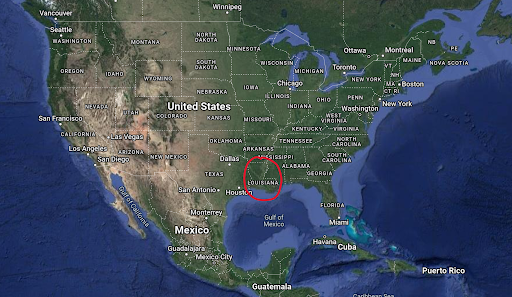Nick Spinelli and Zach Stankovics
The Oysters of New Orleans
Main Imports
Rice
Seafood (Oysters)
Spices and Seasonings
Sausages and Andouille
Crawfish
French Bread
Coffee and Chicory
Cajun and Creole Seasonings
Hot Sauce
Rum
New Orleans' primary economic role is as a port city and a center for trade and distribution
New Orleans
New Orleans is a Louisiana city on the Mississippi River, near the Gulf of Mexico. Nicknamed the "Big Easy," it's known for its round-the-clock nightlife, vibrant live-music scene and spicy, singular cuisine reflecting its history as a melting pot of French, African and American cultures. Embodying its festive spirit is Mardi Gras, the late-winter carnival famed for raucous costumed parades and street parties.
New Orleans is located in between the Mississippi River and two lakes that connect to the Gulf of Mexico. The two lakes that connect to the gulf are Lake Pontchartrain and Lake Borgne. Beyond the two lakes are the Chandeleur and Breton Sound, that are managed by the Louisiana Legislature, Wildlife and Fisheries Commision, and the LDWF. Louisiana has ample habitat to foster abundant Oyster populations.
Fun Facts
Louisiana produces approximately one-third of the nation’s oysters.
Louisiana currently experiences a shell deficit – most shells removed from the coast is not returned.
Oysters that are consumed in restaurants often end up in landfills.
85% of oyster reefs have been lost globally
Main Exports
Seafood (Oysters)
Cajun and Creole Food Products
Sugarcane and Sugar Products
Rice
Hot Sauce
Spirits and Distilled Products
Coffee
Traditional Sausages
New Orleans' primary economic role is as a port city and a center for trade and distribution
Life Cycle
Ports
Once the Oysters are caught, they are immediately sorted on the fishing vessel. Then the Oysters are stored in ice or refrigerated seawater, before being brought to ports for further processing.
Processing
Processing Oysters includes inspecting them for any imperfections as well as pearls that they may have inside them.
Packaging
After processing, the oysters are packaged as fresh, frozen, or high value products. Once in its sorted variety, it is packaged airtight and cold stored before being distributed.
Distribution
The oysters are then sold to wholesalers, distributors, or retailers including grocery stores and seafood markets. Wholesalers and retailers then sell the oysters to restaurants, hotels, and other food services who don’t buy oysters directly from the supplier. Consumers can then purchase the oysters as dishes at restaurants or directly from grocery stores or seafood markets.
Gentilly Landfill
Non- recyclables and non- hazardous waste are transported by trucks from garbage bins both residential and commercial. The waste is then brought to Gentilly landfill.
Composting
Compost NOW is a New Orleans program promoting residential food waste collection. They collaborate with local farms and gardens for "direct-to-farm" or "direct-to-garden" frozen food scrap drop-offs. Multiple daily drop-off locations are available across the city, accepting FROZEN fruit and vegetable scraps, including peels, pits, seeds, eggshells, nut shells, tea bags, coffee grounds, filters, plain grains, plain pasta, or plain bread in a paper or compostable bag, or in a reusable container. However, they do not accept meat, bones, dairy, or oily foods. Freezing the scraps prevents odors and pests, benefiting both collection sites and residents, while also accelerating decomposition for the farms they support. It's a win-win-win solution for all involved parties.
Galvez Garden is 10:00am-1:00pm every SUNDAY
Sprout NOLA is 3:30-5:00pm every MONDAY
Recirculating Farms is 9am-5pm on TUESDAYs and 9:00am-noon on FRIDAYS & SATURDAYS
The Audubon Park Golf Course Clubhouse collection is 4:00-5:30pm every WEDNESDAY
EarthLab in the Marigny is 4:30-6:30pm on THURSDAYS
Speak Easy Farm is 8am-noon on FRIDAYS
Crown Community Garden is 9:00am-5:30pm every SATURDAY
Sugar Roots Farm is 9:00am-3:30pm DAILY
Schmelly’s Dirt Farm is 6am to sunset DAILY
Recycling Containers
The City of New Orleans offers once weekly curbside recycling to properties that are eligible for the collection of solid waste by the City
Residents who are eligible for City sanitation services will receive one free recycling container
In the areas outside the French Quarter and Downtown Development District, the City provides one free 64-gallon blue Recycling Roll Cart per eligible unit.
In the French Quarter and Downtown Development District, the City provides one free 18-gallon blue Recycling Bin per eligible unit.
Sustainability and Recycling Initiatives
Shell Recycling Rewards incentives program that educates and encourages patrons to help Jazz Fest collect more recyclable materials
Festival-goers can participate at one of the two Recycling Rewards Tents by acquiring a mesh bag to collect cans and bottles around the Festival.
Once the bag is full, participants can return it to one of the two Recycling Rewards Tents to be entered into a Festival sweepstakes to win two VIP Grand Marshal passes for a weekend of their choice in 2024.
Recycling locations, water refill stations, and bicycle parking are marked on Festival maps.
Behind the scenes, we will continue to work with our food vendors to collect used cooking oil, which is then turned into fuel for local shrimping boats.
Finally, in conjunction with our Stage Team, we are excited to pilot a battery recycling program, collecting batteries from talent’s audio devices after rehearsals and performances.
Oysters and their Reefs
Purpose
Oyster shell recycling is primarily aimed at returning oyster shells to their natural habitat, which helps in the restoration and preservation of the Gulf Coast's oyster reefs. These reefs are vital for the overall health of the coastal ecosystem.
Collection of Oysters
The program starts by collecting discarded oyster shells from local restaurants, seafood markets, and other sources. Oyster shells are an essential component for the growth of new oysters.
Curing and Preparation
Collected oyster shells are then cleaned and cured to remove any organic material, bacteria, or contaminants. This ensures that the shells are safe to reintroduce into the marine environment.
Reef Construction
After preparation, the cured oyster shells are strategically placed on the seafloor in areas where oyster reefs have been depleted or degraded. This may involve creating reef structures or adding to existing natural reefs.
Oyster Larvae Settlement
The recycled oyster shells provide a suitable substrate for oyster larvae to attach to and grow. Oyster larvae, which are free-swimming in their early stages, attach themselves to the shells and gradually develop into mature oysters.
Oyster Reef Restoration
Over time, these new oysters grow and form the foundation of a thriving oyster reef. Oyster reefs provide numerous ecological benefits, including water filtration, habitat for various marine species, and shoreline protection. Specifically coastal erosion and storm surge. (Breaking waves)
The CRCL
CRCL established the Oyster Shell Recycling Program (OSRP) in 2014 to keep shell out of landfills and slow coastal land loss.
Since starting the program in 2014, we have recycled more than 13 million pounds of shell and protected over 8,000 feet of shoreline along the coast.
100% of the shell is returned to Louisiana waters.
In partnership with local communities and over 2,000 volunteers, CRCL has constructed over 8,000 feet of oyster reef living shoreline protection with our recycled shell.
Our reefs enhance local fisheries, reduce shoreline erosion as much as 50%, and help protect irreplaceable cultural heritage sites.
CRCL constructs one recycled oyster reef per year.
Each reef is monitored annually to assess shoreline changes and biological development.
We have found that for every 3 recycled shells returned to the water, 2 oysters are grown.
Our Intervention
Oyster reefs can provide barriers between land and water on shorelines while also protecting marshes from retreating into the mainland. As a result, we will implement a design for an oyster reef that protects New Orleans’ shorelines and marshes from rising sea levels and erosion. The reef will grow outwards from areas that are most prone to flooding. To implement an oyster reef at the scale of the city, we will have to look into creating potential new infrastructures such as oyster collection areas, distribution routes, and assembly plants.
Once you shuck ’em, don’t just chuck ’em!
Oysters
Biloxi: 2640 feet / 868 tons = 3.04 ft/ton
Pointe-au-Chien #1: 400 feet / 200 tons = 2 ft/ton
Barataria: 3960 feet / 800 tons = 4.95 ft/ton
Plaquemines: 300 feet / 150 tons = 2 ft/ton
Pointe-au-Chien #2: 400 feet / 200 tons = 2 ft/ton
Average = 2.798 ft/ton
13 million pounds of shells collected in 9 years = 6500 tons.
About 722 tons for 1 year = 2,020 feet
2,020 feet x 5 years = 10,100 feet
2,020 feet x 10 years = 20,200 feet
Oyster Uses on Land
Pathways and Driveways: Crushed oyster shells can be used to create attractive and eco-friendly garden pathways and driveways. The shells' light color reflects sunlight, keeping the surface cooler and reducing the need for air conditioning during hot summer months
Oyster Shell Mulch: Crushed oyster shells serve as an excellent mulch for gardens. Their porous nature helps improve soil drainage, regulate pH levels, and provide essential minerals like calcium to plants, promoting healthy growth.
Note: Proposed Reef Additions
Our Goal is to get New Orleans to recycle more oysters to help extend the reefs around New Orleans. Creating these reefs will allow more oysters to grow as well as to help serve as a natural protective piece for harmful weather. To help incentivize people to save and recycle their oysters, we have created a reward for the neighborhood that donates the most amount of oysters. The neighborhood with the most oysters donates, gets a park built in their neighborhood. Any oysters that were not put towards building the reef will be used to help construct and fertilize the parks.
Oyster Reefs
Current Oyster Reefs
Biloxi Marsh Oyster Reef
Plaquemines Community Reef
Barataria Bay Reef
Pointe-au-Chien Living Shoreline (2 parts)
Biloxi Marsh Oyster Reef
The oyster reef at Biloxi Marsh was constructed in 2016 due to habitat loss. Habitat loss is a result of erosion on the marsh edge by storm waves. The oyster reef is intended to slow deterioration of the marsh. It is made out of 868 tons of oysters and is half a mile long. The oysters are held together by gabion baskets.
Pointe-au-Chien #1
Pointe-au-Chien #1 was built in 2018/19 to “provide shoreline stabilization while creating vital fisheries and protecting the Pointe-au-Chien Indian Tribe mound complex”. The reef is 400 feet long and consists of 200 tons of oysters held together by bags.
Barataria Bay Reef
The Barataria Bay Reef was built in 2020 to “create habitat for new oysters and other aquatic life”, while stabilizing an eroding shoreline. The Reef is ¾ of a mile long and consists of 800 tons of oysters held together by gabion baskets.
Plaquemines Community Reef
The Plaquemines Community Reef was built in 2021/22 to protect a culturally significant mound and marsh while restoring ecology. The reef is 300 feet long and consists of 150 tons of oysters held together by bags.
Pointe-au-Chien #2
Pointe-au-Chien #2 was built in 2022/23 to protect sacred tribal mounds where Pointe-au-Chien tribe ancestors had been buried. The reef is 400 feet long and consists of 200 tons of oysters held together by bags.
















